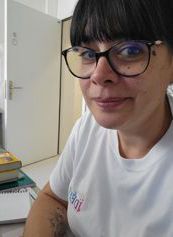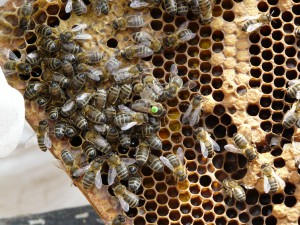
Engineer in biological techniques and Assistant of Prevention
Institut Diversité Écologie et Évolution du Vivant (IDEEV)
UMR9191 CNRS – Université Paris Saclay – IRD
Laboratoire Évolution, Génomes, Comportement et Écologie
Bureau 1310
12 Route 128
91190 Gif-sur-Yvette
Tel: +33-1 69 15 50 86 – helene.legout@cnrs.fr – helene.legout@universite-paris-saclay.fr
Communications
La Méthode Scientifique de France Culture : June 6, 2022 program, The bee is prowling. With Julie Carcaud, Aurore Avargues-Weber – Report of the day, with Hélène Legout.
https://radiofrance.fr/franceculture/podcasts/la-methode-scientifique/les-abeilles-3219704
Characterization of the genetic diversity of bee populations over the range – Scientific support for the operation of genetic conservatories of black bees in France and expertise on bee populations – Health monitoring of colonies through molecular characterization of bee parasites.
– European project BEEHOPE, an innovative strategy based on sustainable beekeeping to reduce the decline of bees (2015-2018)
– Project to characterize bees in Benin and their parasites (2015-2020)
– ApiNoire Normandie project: Establishment of conservatories and fertilization apiaries for the black bee of Normandy. Sustainable beekeeping using local resources (2019-2023)
– Project financed by the Fondation de France: Effects of hybridization on the apicultural performances of Apis mellifera mellifera in sedentary beekeeping (2021-2023) – Exploring the therapeutic potential of hive products and insect nests from Benin (2024-2025) – Investagating mitochondrial intergenic region variations and their role in honeybee metabolism and adaptation (started in 2025)
Publications
(works of domestic bee genetics – preservation – 2003 to date)
Expertise reports on bee populations for their conservation: Lionel Garnery, Hélène Legout. Principle of the study, method, results and interpretations, recommendations for beekeeping management with the specifications of the conservatories (https://www.fedcan.org/)
2023: Expertise of the bee populations of: North of Europe (Norway, Ireland, Wales) (300 samples), and Corsica (200 samples)
2022: Expertise of the bee populations of: Valencienne (500 samples)
2021: Expertise of the bee populations of: Savoie (400 samples), Landes (200 samples), Normandie (127 samples), L’Allier (33 samples), Pyrénées atlantiques (43 samples), l’Ile d’Oléron (150 samples), l’INRAe de Bordeaux (30 samples), Côtes d’Armor (25 samples), L’Avesnois (300 samples), Haute-Savoie (50 samples), Conservatoire des Races d’Aquitaine (300 samples).
2020: Expertise of the bee populations of: Savoie (170 samples), Loire-Atlantique (40 samples), Finistère (270 samples)
2019: Expertise of bee populations of: Savoie (250 samples), New Caledonia (100 samples), Ardèche (211 samples), Yvelines (344 samples)
2018: Expertise of bee populations of: Savoie (696 samples), Ile de Ouessant (208 samples), Les Landes (164 samples)
2017: Expertise of bee populations of: Savoie (359 samples), Ile d’Oléron (313 samples), New Caledonia (344 samples)
Héloïse Bastide, Hélène Legout, Noé Dogbo, David Ogereau, Carolina Prediger, Julie Carcaud, Jonathan Filee, Lionel Garnery, Clément Gilbert, Frederic Marion-Poll, Fabrice Requier, Jean-Christophe Sandoz and Amir Yassin (2024) The genome of the blind bee louse fly reveals deep convergences with its social host and illuminates Drosophila origins. Current Biology ,34,1-11. https://doi.org/10.1016/j.cub.2024.01.034
Kelomey, A., A. Paraiso, H. Sina, H. Legout, A. Adjanohoun, L. Garnery & L. Baba-Moussa (2017) Genetic variability of the mitochondrial DNA in honeybees (Apis mellifera L) from Benin. Journal of Agricultural Science and Technology, A7, 557-566.
Kelomey, A. E., A. Paraiso, H. Sina, H. Legout, L. Garnery & L. Baba-Moussa (2017) Genetic characterization of the honeybee ectoparasitic mite Varroa destructor from Benin (West Africa) using mitochondrial and microsatellite markers. Experimental and Applied Acarology, 72, 61-67. DOI : 10.1007/s10493-017-0141-y
Loucif-Ayad, W., M. Achou, H. Legout, M. Alburaki & L. Garnery (2015) Genetic assessment of Algerian honeybee populations by microsatellite markers. Apidologie, 46, 392-402. DOI : 10.1007/s13592-014-0331-0
Bertrand, B., M. Alburaki, H. Legout, S. Moulin, F. Mougel & L. Garnery (2015) MtDNA COI-COII marker and drone congregation area: An efficient method to establish and monitor honeybee (Apis mellifera L.) conservation centres. Molecular Ecology Resources, 15, 673-683. DOI : 10.1186/1471-2156-14-117
Bénédicte Bertrand, Mohamed Alburaki, Hélène Legout, Sibyle moulin, Florence Mougel, Lionel Garnery. 2015 Mt DNA COI-COII marker and Drone Congregation Area: An efficient method to establish and monitor honeybee (Apis mellifera L.) conservation centers. Molecular Ecology Resources (in press)
Wahida Loucif-Ayad, Mohamed Achou, Hélène Legout, Mohamed Alburaki, Lionel Garnery. 2014 Genetic assessment of Algerian honeybee populations by microsatellite markers. Apidologie nov.2014
Alburaki M., Bertrand B., Legout H., Moulin S., Alburaki A., Sheppard W.S., Garnery, L. 2013 A fifth major genetic group among honeybees revealed in Syria. BMC Genetics, 14:117. DOI : 10.1186/1471-2156-14-117
Alburaki, M., Alburaki, A., Legout, H., Moulin, S., Garnery, L. 2011. Mitochondrial structure of Eastern honey bee populations from Syria, Lebanon and Iraq. Apidologie, 42:628-641. DOI : 10.1007/s13592-011-0062-4
Rortais A., Arnold G., Alburaki M., Legout H., Garnery L. 2010. Review of the DraI COI-COII Test for the conservation of the black honeybee (Apis mellifera mellifera). Conservation Genetics Resources vol.3, 383-391.
Rortais A., G. Arnold., H. Legout., L. Garnery. In prep. Apis mellifera mellifera: mitochondrial introgressions in France and Belgium and haplotypic diversity in Europe.
Garnery L., M. D. Meixner, H. Legout., I. Giraud, A. Rortais, and W. S. Shepperd. In prep. Multilocus microsatellite analysis confirms the congruence of a fourth major evolutionary lineage of honey bees (Apis mellifera L.) with that previously hypothesized by morphology
(travaux de Génétique quantitative et sur l’adaptation des Drosophiles à leur environnement – 2001-2006)
DAVID J.R, ARARIPE L.O, BITNER-MATHE B.C, CAPY P, GONI B, KLACZKO L.B, LEGOUT H, MARTINS M.B, VOUIDIBIO J, YASSIN A and MORETEAU B 2006 Quantitative trait analysis and geographic variability of natural populations of Zaprionus indianus, a recent invader in Brazil Heredity 96: 53
DAVID J.R, ARARIPE L.O, BITNER-MATHE B.C, CAPY P, GONI B, KLACZKO L.B, LEGOUT H, MARTINS M.B, VOUIDIBIO J, YASSIN A and MORETEAU B 2006 Sexual dimorphism of body size and sternopleural bristle number: a comparison of geographic populations of an invasive cosmopolitan drosophilid Genetica 128: 109
JEAN R. DAVID, HELENE LEGOUT and BRIGITTE MORETEAU 2006 Phenotypic plasticity of Body Size in a temperate population of Drosophila melanogaster: when the temperature-size rule does not apply. Journal of Genetics 85(1): 9
DAVID J.R., ARARIPE L.O, CHAKIR M., LEGOUT H., LEMOS B., PETAVY G., ROHMER C., JOLY D. and MORETEAU B. 2005 Male sterility at extreme temperatures: a significant but neglected phenomenon for understanding Drosophila climatic adaptations. J. Evol. Biol. 18(4): 838 pdf url
DAVID J.R., GIBERT P., LEGOUT H., PETAVY G., CAPY P. and MORETEAU B. 2005 Isofemale lines in Drosophila: an empirical approach to quantitative traits analysis in natural populations. Heredity 94: 3
AYRINHAC A., DEBAT V., GIBERT P., KISTER A.-G., LEGOUT H., MORETEAU B., VERGILINO R. and DAVID J.R. 2004 Cold adaptation in geographical populations of D. melanogaster : phenotypic plasticity is more important than genetic variability. Functional Ecology 18: 700
MIGNON-GRASTEAU S., DAVID J.R., GIBERT P., LEGOUT H., PETAVY G. and MORETEAU B. 2004 REML estimates of genetic parameters of sexual dimorphism of wing and thorax length in Drosophila melanogaster. J. Genet. 83: 163
DAVID J.R., GIBERT P., MIGNON-GRASTEAU S., LEGOUT H., PETAVY G., BEAUMONT C. and MORETEAU B. 2003 Genetic variability of sexual size dimorphism in a natural population of Drosophila melanogaster : an isofemale line approach. Journal of Genetics 82(3): 79
DEBAT V, BEGIN M, LEGOUT H and DAVID J R 2003 Allometric and nonallometric components of Drosophila wing shape respond differently to developmental temperature Evolution 57: 2773

